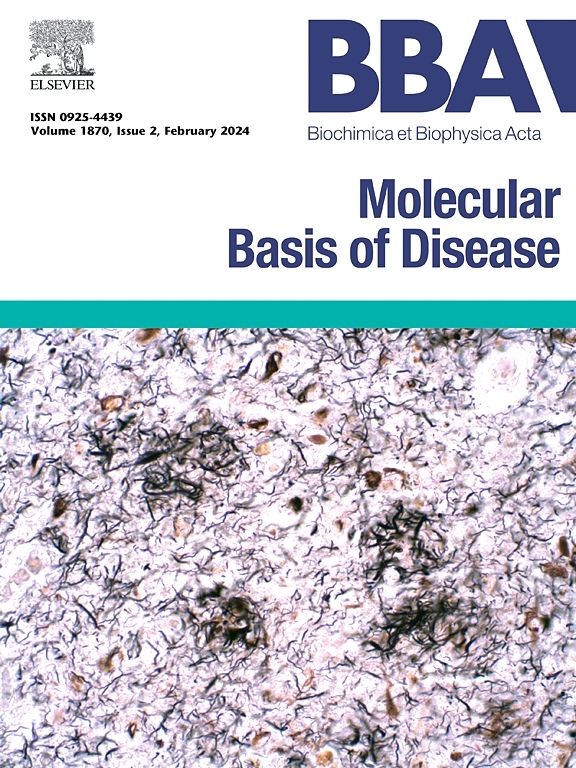Multiple classes of human intracellular Heme-binding proteins with pathology-associated polymorphisms of heme coordinating residues
IF 4.2
2区 生物学
Q2 BIOCHEMISTRY & MOLECULAR BIOLOGY
Biochimica et biophysica acta. Molecular basis of disease
Pub Date : 2025-03-22
DOI:10.1016/j.bbadis.2025.167799
引用次数: 0
Abstract
Heme (Iron II-Protoporphyrin IX) is the pigment of life in all organisms and as a prosthetic group in vital hemoproteins contributes to pleiotropic molecular activities. In blood plasma, free heme is scavenged by hemopexin, albumin and several other proteins, while its biosynthesis, intracellular content and trafficking are normally monitored, and tightly regulated by an extensive network of diverse heme-binding proteins (HeBPs). The proteomic identification of numerous human HeBPs in recent studies prompted us to review, whether any of the identified HeBPs carry heme-binding motifs (HBMs) that exhibit genetic variations associated with pathologies. We improvised on a stepwise analytical methodology to identify HeBPs carrying disease-associated genetic (Single Nucleotide Polymorphisms-SNPs) and epigenetic (Post Translational Modifications-PTMs) variation within HBMs. Using the UniProt protein database, the HeMoQuest-WESA algorithms as well as the dbSNP, ClinVar and PhosphoSitePlus databases, we identified 1250 unique intracellular HeBPs containing 265 species with pathology-associated SNPs within putative HBMs. Among those, 136 exhibit pathology-associated polymorphisms in central heme coordinating residue positions of HBMs. We have noted over 15 protein classes of HeBPs with 377 encoded heme coordinating pathology polymorphisms, that based on population minor allele frequency (MAF) ratios, include 227 rare (<1 % MAF) and 4 common (>5 % MAF) variants. Among the latter is the cochaperone BAG3 rs2234962 that introduces the C151R substitution and varies considerably among populations. In addition, 3 more common variants were identified for the HeBPs CAST (rs754615), SERPINB8 (rs3826616) and DUOX2 (rs57659670). Also, 15 variants in 10 genes, including the Tyrosine-protein kinase ABL1 rs1060499547 (Y226C), introduce substitutions of Tyrosines (Y) normally phosphorylated. As substitutions and epigenetic marks can significantly alter the interactions of heme with HBMs, we propose that such variations can be associated with clinical pathologies.
具有血红素配位残基病理相关多态性的多类人细胞内血红素结合蛋白。
血红素(Iron II-Protoporphyrin IX)是所有生物的生命色素,是重要的血红蛋白中的一个假基,参与多效性分子活动。在血浆中,游离血红素被血凝素、白蛋白和其他几种蛋白质清除,而其生物合成、细胞内含量和运输通常受到多种血红素结合蛋白(hebp)组成的广泛网络的监测和严格调节。在最近的研究中,许多人类hebp的蛋白质组学鉴定促使我们回顾,是否有任何已鉴定的hebp携带血红素结合基序(HBMs),表现出与病理相关的遗传变异。我们临时制定了一种逐步分析方法,以鉴定HBMs中携带疾病相关遗传(单核苷酸多态性- snp)和表观遗传(翻译后修饰- ptms)变异的hebp。利用UniProt蛋白数据库、hemquest - wesa算法以及dbSNP、ClinVar和PhosphoSitePlus数据库,我们鉴定出1250个独特的细胞内hebp,其中包含265个在假定的HBMs中具有病理相关snp的物种。其中136例在HBMs的中心血红素配位残基位置表现出病理相关的多态性。基于群体次要等位基因频率(MAF)比率,我们注意到超过15种蛋白质类的hebp具有377种编码血红素协调病理多态性,其中包括227种罕见(5 % MAF)变异。后者是cochaperone BAG3 rs2234962,它引入了C151R替代,并且在人群中差异很大。此外,hebp CAST (rs754615)、SERPINB8 (rs3826616)和DUOX2 (rs57659670)的3个常见变异被鉴定出来。此外,包括酪氨酸蛋白激酶ABL1 rs1060499547 (Y226C)在内的10个基因中的15个变体引入了酪氨酸(Y)正常磷酸化的取代。由于替换和表观遗传标记可以显著改变血红素与HBMs的相互作用,我们认为这种变异可能与临床病理有关。
本文章由计算机程序翻译,如有差异,请以英文原文为准。
求助全文
约1分钟内获得全文
求助全文
来源期刊
CiteScore
12.30
自引率
0.00%
发文量
218
审稿时长
32 days
期刊介绍:
BBA Molecular Basis of Disease addresses the biochemistry and molecular genetics of disease processes and models of human disease. This journal covers aspects of aging, cancer, metabolic-, neurological-, and immunological-based disease. Manuscripts focused on using animal models to elucidate biochemical and mechanistic insight in each of these conditions, are particularly encouraged. Manuscripts should emphasize the underlying mechanisms of disease pathways and provide novel contributions to the understanding and/or treatment of these disorders. Highly descriptive and method development submissions may be declined without full review. The submission of uninvited reviews to BBA - Molecular Basis of Disease is strongly discouraged, and any such uninvited review should be accompanied by a coverletter outlining the compelling reasons why the review should be considered.

 求助内容:
求助内容: 应助结果提醒方式:
应助结果提醒方式:


